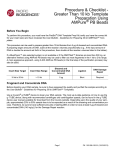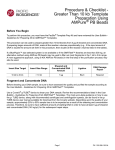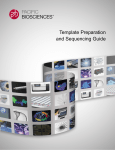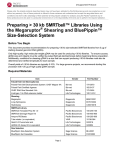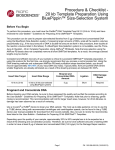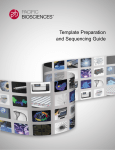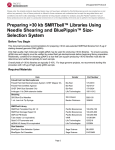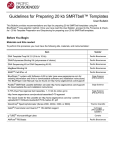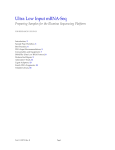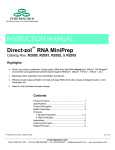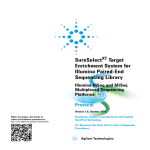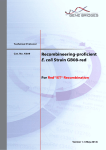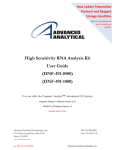Download as low as 100 ng of gDNA
Transcript
PacBio SampleNet – Shared Protocol Please note: the shared protocols described herein may not have been validated by Pacific Biosciences and are provided as-is and without any warranty. Use of these protocols is offered to those customers who understand and accept the associated terms and ® conditions and wish to take advantage of their potential to help prepare samples for analysis using the PacBio system. If any of these protocols are to be used in a production environment, it is the responsibility of the end user to perform the required validation. 10 kb to 20 kb Template Preparation and Sequencing with Low-Input DNA Before You Begin To perform this procedure, you must have the PacBio®: • • • • • • DNA Template Prep Kit DNA/Polymerase Binding Kit MagBead Kit DNA Sequencing Kit DNA Control Complex SMRT® Cells for standard sequencing This procedure can be used to prepare 10-20 kb libraries from 50 ng up to 200 ng of sheared and concentrated DNA, or at least 100 ng into shearing. Note: for input amounts between 200 ng and 1 µg, the standard 10 kb library prep protocol may be used. Insert Size Target 10 to 20 kb Insert Size Range 8 kb to 22 kb Sheared and Concentrated DNA Amount 50 to 200 ng Ligation DNA Damage Repair Blunt Required Fragment and Concentrate DNA Use a Covaris® g-TUBE® device to shear your DNA sample, following the g-TUBE user manual available for download from the Covaris website, with one change -- reduce the sample volume from 150 µL to 50 µL. Note: After the first spin, make sure that all of the sample has passed into the lower chamber. If any sample remains, re-spin. If necessary, add 10 µL EB or TE to the upper chamber, flick the g-TUBE or pipette up and down several times, and spin again. Depending upon the quality of your sample, approximately 20% to 50% sample loss is to be expected as a result of the shearing and concentration process. Page 1 PacBio SampleNet – Shared Protocol STEP 1 Concentrate DNA Add 0.5X volume of AMPure® PB magnetic beads. μL of sample X 0.5X = μL of beads Note that the beads must be brought to room temperature and all AMPure PB bead purification steps should be performed at room temperature. Before using, mix the bead reagent well until the solution appears homogenous. Pipette the reagent slowly since the bead mixture is viscous and precise volumes are critical to the purification process. Consistent and efficient recovery of your sample is critical to successful SMRTbell™ template preparation. If using this protocol for the first time, we strongly recommend that you process a control sample first. Using the DNA shearing methods and subsequent AMPure PB bead purification steps described below, you should recover approximately 50%-80% of your input DNA (by mass). Typical yields, from pre-purified DNA (where smaller fragments are already eliminated as a result of the shearing process) are between 80-100%. 2 Mix the bead/DNA solution thoroughly. 3 Quickly spin down the tube (for 1 second) to collect the beads. 4 Allow the DNA to bind to beads by mixing in a VWR® vortex mixer at 2000 rpm for 10 minutes at room temperature. Note that the bead/DNA mixing is critical to yield. After mixing, the bead/DNA mixture should appear homogenous. We recommend using a VWR vortex mixer with a foam microtube attachment (see the Guide’s Overview section for part numbers). If using other instrumentation, ensure that the mixing is equally vigorous. Failure to thoroughly mix the DNA with the bead reagent will result in inefficient DNA binding and reduced sample recoveries. 5 Spin down the tube (for 1 second) to collect beads. 6 Place the tube in a magnetic bead rack until the beads collect to the side of the tube and the solution appears clear. The actual time required to collect the beads to the side depends on the volume of beads added. 7 With the tube still on the magnetic bead rack, slowly pipette off cleared supernatant and save in another tube. Avoid disturbing the bead pellet. If the DNA is not recovered at the end of this Procedure, you can add equal volumes of AMPure PB beads to the saved supernatant and repeat the AMPure PB bead purification steps to recover the DNA. 8 Wash beads with freshly prepared 70% ethanol. Note that 70% ethanol is hygroscopic and should be prepared FRESH to achieve optimal results. Also, 70% ethanol should be stored in a tightly capped polypropylene tube for no more than 3 days. – Do not remove the tube from the magnetic rack. – Use a sufficient volume of 70% ethanol to fill the tube (1.5 mL for 1.5 mL tube or 2 mL for 2 mL tube). Slowly dispense the 70% ethanol against the side of the tube opposite the beads. Let the tube sit for 30 seconds. – Do not disturb the bead pellet. – After 30 seconds, pipette and discard the 70% ethanol. 9 Repeat step 8 above. Page 2 Notes PacBio SampleNet – Shared Protocol STEP 10 Concentrate DNA Remove residual 70% ethanol and dry the bead pellet. – Remove tube from magnetic bead rack and spin to pellet beads. Both the beads and any residual 70% ethanol will be at the bottom of the tube. – Place the tube back on magnetic bead rack. – Pipette off any remaining 70% ethanol. 11 Check for any remaining droplets in the tube. If droplets are present, repeat step 10. 12 Remove the tube from the magnetic bead rack and allow beads to air-dry (with the tube caps open) for 30 to 60 seconds. 13 Add 37 μL of Pacific Biosciences’ Elution Buffer to the beads to elute the DNA. – Mix until homogeneous. – Vortex for 1-2 minutes at 2000 rpm. – Spin the tube down to pellet beads, then place the tube back on the magnetic bead rack. – Carefully collect the eluted sample. – Discard the beads. 14 Proceed to the next step, if possible. If necessary, store at -20°C to continue later. Page 3 Notes PacBio SampleNet – Shared Protocol Repair DNA Damage Use the following table to repair any DNA damage. 1. In a LoBind microcentrifuge tube, add the reagents below. Note: premix damage repair buffer, NAD+, ATP high, and dNTPs if you are preparing more than 1 sample. Reagent Sheared DNA Tube Cap Color Stock Conc. − Volume Final Conc. 37 μL − DNA Damage Repair Buffer 10 X 5.0 μL 1X NAD+ 100 X 0.5 μL 1X ATP high 10 mM 5.0 μL 1 mM dNTP 10 mM 0.5 μL 0.1 mM DNA Damage Repair Mix 2.0 μL Total Volume 50.0 μL Notes − *To determine the correct amount of H2O to add, use your actual DNA amount noted in the Notes column. 2. Mix the reaction well by pipetting or flicking the tube. 3. Spin down contents of tube with a quick spin in a microfuge. 4. Incubate at 37ºC for 20 minutes, then return the reaction to 4ºC for 1 minute. Repair Ends Use the following table to prepare your reaction then purify the DNA. Reagent DNA (Damage Repaired) End Repair Mix Tube Cap Color Stock Conc. − 20 X Total Volume Volume Final Conc. 50 μL − 2.0 μL 1X 52.0 μL − 1. Mix the reaction well by pipetting or flicking the tube. 2. Spin down contents of tube with a quick spin in a microfuge. 3. Incubate at 25ºC for 5 minutes (no longer), return the reaction to 4ºC. Page 4 Notes PacBio SampleNet – Shared Protocol STEP Purify DNA 1 Add 0.5X volume of AMPure PB beads to the End-Repair reaction. (For detailed instructions on AMPure PB bead purification, see the Concentrate DNA section). 2 Mix the bead/DNA solution thoroughly. 3 Quickly spin down the tube (for 1 second) to collect the beads. Do not pellet beads. 4 Allow the DNA to bind to beads by shaking in a VWR vortex mixer at 2000 rpm for 10 minutes at room temperature. 5 Spin down the tube (for 1 second) to collect beads. 6 Place the tube in a magnetic bead rack to collect the beads to the side of the tube. 7 Slowly pipette off cleared supernatant and save (in another tube). Avoid disturbing the bead pellet. 8 Wash beads with freshly prepared 70% ethanol. 9 Repeat step 8 above. 10 Remove residual 70% ethanol and dry the bead pellet. – Remove tube from magnetic bead rack and spin to pellet beads. Both the beads and any residual 70% ethanol will be at the bottom of the tube. – Place the tube back on magnetic bead rack. – Pipette off any remaining 70% ethanol. 11 Check for any remaining droplets in the tube. If droplets are present, repeat step 10. 12 Remove the tube from the magnetic bead rack and allow beads to air-dry (with tube caps open) for 30 to 60 seconds. 13 Elute the DNA off the beads in 32-33 μL Elution Buffer.: – Mix until homogeneous. – Vortex for 1-2 minutes at 2000 rpm. – Spin the tube down to pellet beads, then place the tube back on the magnetic bead rack. – Carefully collect the eluted sample. – Discard the beads. 14 Proceed to the next step if possible. If necessary, store at -20°C to continue later. Page 5 Notes PacBio SampleNet – Shared Protocol Prepare Blunt-Ligation Reaction Use the following table to prepare your blunt-ligation reaction: 1. In a LoBind microcentrifuge tube (on ice), add the following reagents in the order shown. If preparing a Master Mix, ensure that the adapter is NOT mixed with the ligase prior to introduction of the inserts. Add the adapter to the well with the DNA. All other components, including the ligase, should be added to the Master Mix. Tube Cap Color Reagent Stock Volume Conc. DNA (End Repaired) Final Conc. Notes 32 µl Annealed Blunt Adapter (20 μM) 20 μM 1.0 μL 0.5 μM Mix before proceeding Template Prep Buffer 10 X 4.0 μL 1X ATP low 1 mM 2.0 μL 0.05 mM Mix before proceeding Ligase Total Volume − 30 U/μL 1.0 μL 0.75 U/μL − 40.0 μL − 2. 3. 4. 5. Mix the reaction well by pipetting or flicking the tube. Spin down contents of tube with a quick spin in a microfuge. Incubate at 25ºC for 45 minutes. Incubate at 65ºC for 10 minutes to inactivate the ligase, then return the reaction to 4ºC. You must proceed with adding exonucleases after this step. Add exonucleases to remove failed ligation products. Reagent Tube Cap Color Stock Conc. Ligated DNA Volume 40 μL Mix reaction well by pipetting ExoIII 100.0 U/μL 0.5 μL ExoVII 10.0 U/μL 0.5 μL Total Volume 41 μL 1. Mix the reaction well by pipetting or flicking the tube. 2. Spin down contents of tube with a quick spin in a microfuge. 3. Incubate at 37ºC for 45 minutes, then return the reaction to 4ºC. Do not exceed 1 hour incubation time. You must proceed with purification after this step. Page 6 PacBio SampleNet – Shared Protocol Purify SMRTbell™ Templates There are 2 final purification steps. The first uses 0.5X volumes of AMPure PB beads, followed by purification with 0.45X volumes of AMPure PB beads. STEP Purify SMRTbell™ Templates - First Purification 1 Add 0.5X volume of AMPure PB beads to the exonuclease-treated reaction. (For detailed instructions on AMPure PB bead purification, see the Concentrate DNA section). 2 Mix the bead/DNA solution thoroughly. 3 Quickly spin down the tube (for 1 second) to collect the beads. Do not pellet beads. 4 Allow the DNA to bind to beads by shaking in a VWR vortex mixer at 2000 rpm for 10 minutes at room temperature. 5 Spin down the tube (for 1 second) to collect beads. 6 Place the tube in a magnetic bead rack to collect the beads to the side of the tube. 7 Slowly pipette off cleared supernatant and save (in another tube). Avoid disturbing the bead pellet. 8 Wash beads with freshly prepared 70% ethanol. 9 Repeat step 8 above. 10 Remove residual 70% ethanol and dry the bead pellet. – Remove tube from magnetic bead rack and spin to pellet beads. Both the beads and any residual 70% ethanol will be at the bottom of the tube. – Place the tube back on magnetic bead rack. – Pipette off any remaining 70% ethanol. 11 Check for any remaining droplets in the tube. If droplets are present, repeat step 10. 12 Remove the tube from the magnetic bead rack and allow beads to air-dry (with tube caps open) for 30 to 60 seconds. 13 Elute the DNA off the beads in 50 μL of Elution Buffer. Mix for 10 minute at 2000 rpm: – Mix until homogeneous. – Vortex for 1-2 minutes at 2000 rpm. – Spin the tube down to pellet beads, then place the tube back on the magnetic bead rack. – Carefully collect the eluted sample. – Discard the beads. Page 7 Notes PacBio SampleNet – Shared Protocol STEP Purify SMRTbell™ Templates - Second Purification 1 Add 0.45x volume of AMPure PB beads to the 50 μL of eluted DNA. 2 Mix the bead/DNA solution thoroughly. 3 Quickly spin down the tube (for 1 second) to collect the beads. Do not pellet beads. 4 Allow the DNA to bind to beads by shaking in a VWR vortex mixer at 2000 rpm for 10 minutes at room temperature. 5 Spin down the tube (for 1 second) to collect beads. 6 Place the tube in a magnetic bead rack to collect the beads to the side of the tube. 7 Slowly pipette off cleared supernatant and save (in another tube). Avoid disturbing the bead pellet. 8 Wash beads with freshly prepared 70% ethanol. 9 Repeat step 8 above. 10 Remove residual 70% ethanol and dry the bead pellet. – Remove tube from magnetic bead rack and spin to pellet beads. Both the beads and any residual 70% ethanol will be at the bottom of the tube. – Place the tube back on magnetic bead rack. – Pipette off any remaining 70% ethanol. 11 Check for any remaining droplets in the tube. If droplets are present, repeat step 10. 12 Remove the tube from the magnetic bead rack and allow beads to air-dry (with tube caps open) for 30 to 60 seconds. 13 Elute the DNA off the beads in 8-10 μL of Elution Buffer: – Mix until homogeneous. – Vortex for 1-2 minutes at 2000 rpm. – Spin the tube down to pellet beads, then place the tube back on the magnetic bead rack. – Carefully collect the eluted sample. – Discard the beads. 14 Check quantitation with the Qubit® dsDNA HS Assay Kit. If there is too little sample, estimate concentration based on 10% yield of input amount into damage repair. Page 8 Notes PacBio SampleNet – Shared Protocol Anneal and Bind SMRTbell™ Templates You must have a PacBio DNA Polymerase Binding Kit for this step. To anneal sequencing primer and bind polymerase to SMRTbell templates, follow the Calculator recommendations with the following set-up: 1. Under Edit Sample, enter the Volume to Use and DNA Concentration (measured or estimated assuming 10% library yield). Then select the following: - Magnetic Beads: Yes - Preparation Protocol: Small scale - DNA Control Complex: No - Non-standard: Yes Note the suggested number of SMRT Cells PacBio SampleNet – Shared Protocol 2. Under Optional, enter a Custom Concentration on Plate: -For P4 polymerase, enter 0.025 nM -For P5 polymerase, enter 0.040 nM 3. Under Annealing, pre-mix 10x Primer Buffer and Diluted Sequencing Primer at higher volumes to eliminate small volume pipetting a. Prepare a 10x pre-mix by combining 9.0 µL 10x Primer Buffer and 1.3 µL Diluted Sequencing Primer b. Add 1.03 µL pre-mix to the sample 4. Dilutions. If polymerase is diluted to <8.0 nM, increase the polymerase:template ratio until 8.0 nM final concentration is obtained (or simply dilute polymerase 1/200 in Binding Buffer v3): If this number is <8.0 nM, see recommendation under “Optional” below. PacBio SampleNet – Shared Protocol Increase this number as required until the polymerase dilution is at least 8.0 nM (see below). 5. Use the entire complex to sequence the number of SMRT Cells recommended (by the calculator) in one run. 6. If desired, the bead-bound complex from sample plate can be used the next day by doing the following: -Pool the remaining beads from multiple SMRT Cells. -Add the Bead Binding Buffer to bring the volume to 19 µL (for 1 SMRT Cell), or the required volume for the closest number of SMRT Cells. For example, if 3 cells were run, and the remaining pooled volume is 26 µL, add 2 µL Bead Binding Buffer to bring the volume to 28 µL for 2 SMRT Cells. The required volume for any number of SMRT Cells may be determined with the binding calculator. The expected yield from reused beads depends on the amount of Bead Binding buffer added. If none is needed, it may be close to the original yield (if used the following day). The yield will decrease with longer times between runs. For Research Use Only. Not for use in diagnostic procedures. © Copyright 2014, Pacific Biosciences of California, Inc. All rights reserved. Information in this document is subject to change without notice. Pacific Biosciences assumes no responsibility for any errors or omissions in this document. Certain notices, terms, conditions and/or use restrictions may pertain to your use of Pacific Biosciences products and/or third party products. Please refer to the applicable Pacific Biosciences Terms and Conditions of Sale and to the applicable license terms at http://www.pacificbiosciences.com/licenses.html. Pacific Biosciences, the Pacific Biosciences logo, PacBio, SMR, SMRTbell, and Iso-Seq are trademarks of Pacific Biosciences in the United States and/or certain other countries. All other trademarks are the sole property of their respective owners.











